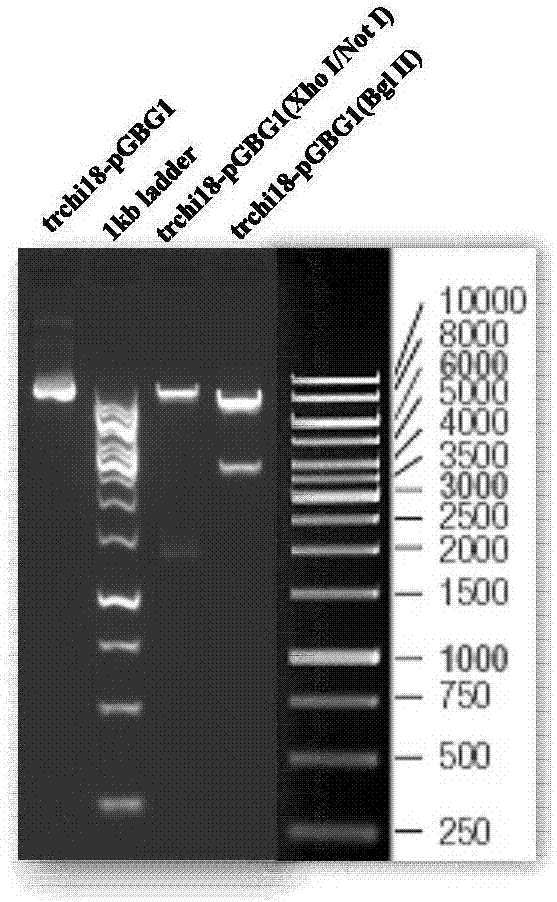Trichoderma reesei chitinase and preparation method and applications thereof
A technology of chitinase and Trichoderma reesei, which is applied in the field of chitinase, can solve the problems of increased production cost of chitosan oligosaccharides and large amount of enzymes, and achieve efficiency improvement, huge application potential, and high-efficiency secretion expression Effect
- Summary
- Abstract
- Description
- Claims
- Application Information
AI Technical Summary
Problems solved by technology
Method used
Image
Examples
Embodiment 1
[0019] Example 1 Codon optimization and total gene synthesis of chitinase gene
[0020] On the premise of not changing the amino acid sequence, the codons of the chitinase (GH18 family) coding gene derived from Trichoderma reesei were optimized, and all the optimized codons were Pichia pastoris preferred codons. For the specific sequence, see SEQ ID NO.2. Compared with the original sequence (as shown in SEQ ID NO.3, GenBankaccession number: XM_006968075), the optimized nucleotide sequence trchi18 has 246 nucleotides changed, and the nucleotide sequence homology is 80%. At the same time, in order to enable efficient and stable secretion and expression of chitinase in Pichia pastoris, the optimized chitinase gene lacks 22 amino acids encoding the 5' signal peptide sequence. The optimized gene sequence was entrusted to Sangong for full synthesis, and the synthesized gene sequence was named chitinase gene trchi18.
Embodiment 2
[0021] The expression vector construction of embodiment 2 chitinase gene trchi18
[0022] First, the cloning vector containing the chitinase gene trchi18 was double-digested with restriction endonucleases Xho I and Not I to obtain the target gene fragment, and the expression vector pGBG1 was double-digested with the same endonucleases, and recovered large fragments. The two recovered products were connected to obtain a recombinant vector named trchi18-pGBG1. In order to confirm that the target chitinase gene has been constructed into the vector, we used Xho I / Not I and Bgl II to carry out double and single digestion of the recombinant vector respectively, and performed agarose gel electrophoresis on the product. The results are as follows: figure 1 Shown: After double enzyme digestion, the target gene fragment appeared between 1000bp and 1500bp, which was consistent with the fragment 1242bp of trchi18; after Bgl II digestion, the expected two fragments appeared, followed by t...
Embodiment 3
[0023] Example 3 Screening of Chitinase Pichia Pichia Engineering Bacteria and Preparation of Chitinase
[0024] After the obtained recombinant plasmid trchi18-pGBG1 was linearized by the restriction endonuclease BglII, gel electrophoresis was used to separate and excise the nucleotide fragment containing the gene of interest (such as figure 2 shown in the larger fragment), electroporation introduced into Pichia pastoris GS115, and the recombinant obtained by screening on the histidine auxotrophic MD plate was spread on the BMMY agar plate containing colloidal chitosan (0.5%) for cultivation , from which the monoclonal strain with the largest hydrolytic circle was screened out. A single colony of the screened monoclonal strain was inoculated in 200 mL of BMGY medium, cultured at 30°C and 250 rpm for 48 hours, the supernatant was discarded by centrifugation, and an equal amount of BMMY was added to induce expression. Add methanol to the final concentration of 1% after 24 hour...
PUM
 Login to View More
Login to View More Abstract
Description
Claims
Application Information
 Login to View More
Login to View More - R&D
- Intellectual Property
- Life Sciences
- Materials
- Tech Scout
- Unparalleled Data Quality
- Higher Quality Content
- 60% Fewer Hallucinations
Browse by: Latest US Patents, China's latest patents, Technical Efficacy Thesaurus, Application Domain, Technology Topic, Popular Technical Reports.
© 2025 PatSnap. All rights reserved.Legal|Privacy policy|Modern Slavery Act Transparency Statement|Sitemap|About US| Contact US: help@patsnap.com



